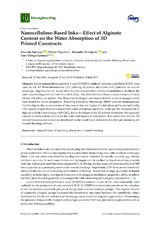Nanocellulose-Based Inks—Effect of Alginate Content on the Water Absorption of 3D Printed Constructs
Autor
Espinosa, E.
Filgueira, Daniel
Rodríguez Pascual, Alejandro
Chinga-Carrasco, Gary
Editor
MDPIFecha
2019Materia
Nanocellulose3D printing
Absorption
Wound dressings
METS:
Mostrar el registro METSPREMIS:
Mostrar el registro PREMISMetadatos
Mostrar el registro completo del ítemResumen
2,2,6,6-tetramethylpyperidine-1-oxyl (TEMPO) oxidized cellulose nanofibrils (CNF) were used as ink for three-dimensional (3D) printing of porous structures with potential as wound dressings. Alginate (10, 20, 30 and 40 wt%) was incorporated into the formulation to facilitate the ionic cross-linking with calcium chloride (CaCl2). The effect of two different concentrations of CaCl2 (50 and 100 mM) was studied. The 3D printed hydrogels were freeze-dried to produce aerogels which were tested for water absorption. Scanning Electronic Microscopy (SEM) pictures demonstrated that the higher the concentration of the cross-linker the higher the definition of the printed tracks. CNF-based aerogels showed a remarkable water absorption capability. Although the incorporation of alginate and the cross-linking with CaCl2 led to shrinkage of the 3D printed constructs, the approach yielded suitable porous structures for water and moisture absorption. It is concluded that the 3D printed biocomposite structures developed in this study have characteristics that are promising for wound dressings devices.

